第五章金属及合金的塑性变形
- 格式:ppt
- 大小:1.38 MB
- 文档页数:71

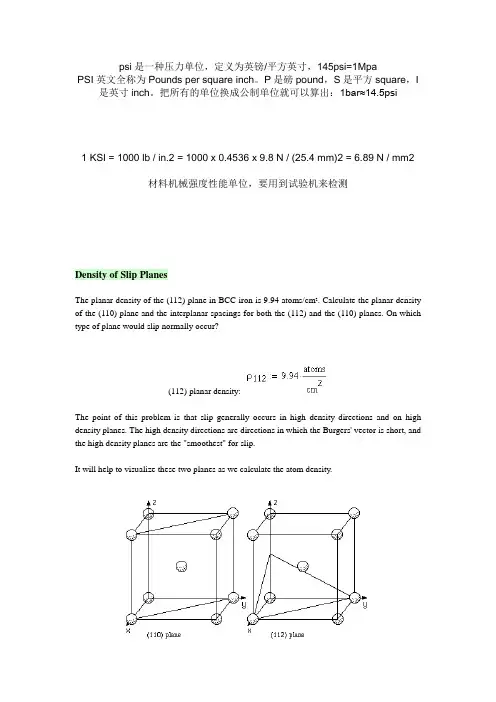
psi是一种压力单位,定义为英镑/平方英寸,145psi=1MpaPSI英文全称为Pounds per square inch。
P是磅pound,S是平方square,I 是英寸inch。
把所有的单位换成公制单位就可以算出:1bar≈14.5psi1 KSI = 1000 lb / in.2 = 1000 x 0.4536 x 9.8 N / (25.4 mm)2 = 6.89 N / mm2材料机械强度性能单位,要用到试验机来检测Density of Slip PlanesThe planar density of the (112) plane in BCC iron is 9.94 atoms/cm2. Calculate the planar density of the (110) plane and the interplanar spacings for both the (112) and the (110) planes. On which type of plane would slip normally occur?(112) planar density:The point of this problem is that slip generally occurs in high density directions and on high density planes. The high density directions are directions in which the Burgers' vector is short, and the high density planes are the "smoothest" for slip.It will help to visualize these two planes as we calculate the atom density.The (110) plane passes through the atom on the lattice point in the center of the unit cell. The plane is rectangular, with a height equal to the lattice parameter a0and a width equal to the diagonal of the cube face, which is 2 a0.Lattice parameter (height):Width:Thus, according to the geometry, the area of a (110) plane would beThere are two atoms in this area. We can determine that by counting the piece of atoms that lie within the circle (1 for the atom in the middle and 4 times 1/4 for the corners), or using atom coordinates as discussed in Chapter 3. Then the planar density isThe interplanar spacing for the (110) planes isFor the (112) plane, the planar density is not quite so easy to determine. Let us draw a larger array of four unit cells, showing the plane and the atoms it passes through.This plane is also rectangular, with a base width of √2 a0 (the diagonal of a cube face), and a height of √3 a0 (the body diagonal of a cube). It has four atoms at corners, which are counted as 1/4 for the portion inside the rectangle (4 x 1/4) and two atoms on the edges, counted as 1/2 for the portion inside the rectangle (2 x 1/2). This is a total of 2 atoms.Base width:Height:Hence, we can calculate the area and density as for the (110) plane.The planar density and interplanar spacing of the (110) plane are larger than that of the (112) plane, thus the (110) plane would be the preferred slip plane1.有一根长为5 m,直径为3mm的铝线,已知铝的弹性模量为70GPa,求在200N的拉力作用下,此线的总长度。
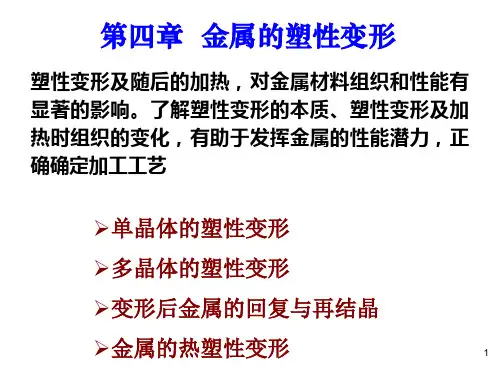
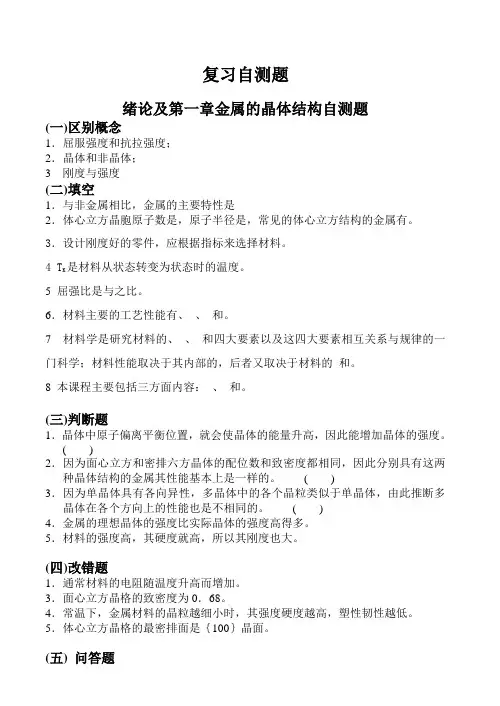
复习自测题绪论及第一章金属的晶体结构自测题(一)区别概念1.屈服强度和抗拉强度;2.晶体和非晶体;3 刚度与强度(二)填空1.与非金属相比,金属的主要特性是2.体心立方晶胞原子数是,原子半径是,常见的体心立方结构的金属有。
3.设计刚度好的零件,应根据指标来选择材料。
是材料从状态转变为状态时的温度。
4 TK5 屈强比是与之比。
6.材料主要的工艺性能有、、和。
7 材料学是研究材料的、、和四大要素以及这四大要素相互关系与规律的一门科学;材料性能取决于其内部的,后者又取决于材料的和。
8 本课程主要包括三方面内容:、和。
(三)判断题1.晶体中原子偏离平衡位置,就会使晶体的能量升高,因此能增加晶体的强度。
( )2.因为面心立方和密排六方晶体的配位数和致密度都相同,因此分别具有这两种晶体结构的金属其性能基本上是一样的。
( )3.因为单晶体具有各向异性,多晶体中的各个晶粒类似于单晶体,由此推断多晶体在各个方向上的性能也是不相同的。
( )4.金属的理想晶体的强度比实际晶体的强度高得多。
5.材料的强度高,其硬度就高,所以其刚度也大。
(四)改错题1.通常材料的电阻随温度升高而增加。
3.面心立方晶格的致密度为0.68。
4.常温下,金属材料的晶粒越细小时,其强度硬度越高,塑性韧性越低。
5.体心立方晶格的最密排面是{100}晶面。
(五) 问答题1.从原子结合的观点来看,金属、陶瓷和高分子材料有何主要区别?在性能上有何表现?2.试用金属键结合的方式,解释金属具有良好导电性、导热性、塑性和金属光泽等基本特性。
(六) 计算作图题1.在一个晶胞中,分别画出室温纯铁(011)、(111)晶面及[111)、[011)晶向。
2.已知一直径为11.28mm,标距为50mm的拉伸试样,加载为50000N时,试样的伸长为0.04mm。
撤去载荷,变形恢复,求该试样的弹性模量。
3.已知a-Fe的晶格常数a=0.28664nm,γ-Fe的晶格常数a=0.364nm。


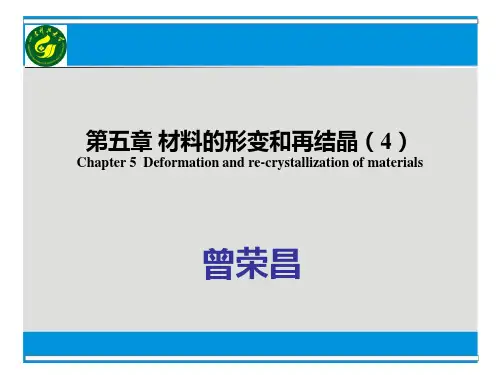

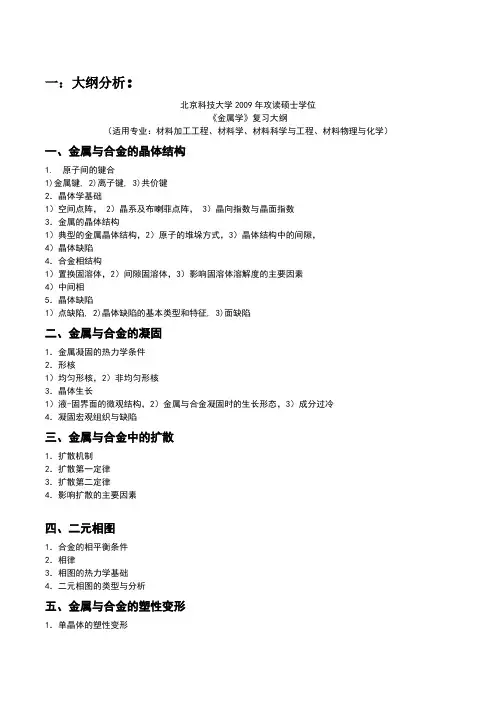
一:大纲分析:北京科技大学2009年攻读硕士学位《金属学》复习大纲(适用专业:材料加工工程、材料学、材料科学与工程、材料物理与化学)一、金属与合金的晶体结构1.原子间的键合1)金属键, 2)离子键, 3)共价键2.晶体学基础1)空间点阵, 2)晶系及布喇菲点阵, 3)晶向指数与晶面指数3.金属的晶体结构1)典型的金属晶体结构,2)原子的堆垛方式,3)晶体结构中的间隙,4)晶体缺陷4.合金相结构1)置换固溶体,2)间隙固溶体,3)影响固溶体溶解度的主要因素4)中间相5.晶体缺陷1)点缺陷, 2)晶体缺陷的基本类型和特征, 3)面缺陷二、金属与合金的凝固1.金属凝固的热力学条件2.形核1)均匀形核,2)非均匀形核3.晶体生长1)液-固界面的微观结构,2)金属与合金凝固时的生长形态,3)成分过冷4.凝固宏观组织与缺陷三、金属与合金中的扩散1.扩散机制2.扩散第一定律3.扩散第二定律4.影响扩散的主要因素四、二元相图1.合金的相平衡条件2.相律3.相图的热力学基础4.二元相图的类型与分析五、金属与合金的塑性变形1.单晶体的塑性变形1)滑移,2)临界分切应力,3)孪生,4)纽折2.多晶体的塑性变形1)多晶体塑性变形的特点,2)晶界的影响,3.塑性变形对组织与性能的影响1)屈服现象,2)应力-应变曲线及加工硬化现象,3)形变织构等六、回复和再结晶1.回复和再结晶的基本概念2.冷变形金属在加热过程中的组织与性能变化3.再结晶动力学4.影响再结晶的主要因素5.晶粒正常长大和二次再结晶七、铁碳相图与铁碳合金1.铁碳相图2.铁碳合金3.铁碳合金在缓慢冷却时组织转变八、固态相变1.固态相变的基本特点2.固态相变的分类3.扩散型相变1)合金脱溶,2)共析转变,3)调幅分解4.非扩散型相变参考书:1.金属学(修订版), 宋维锡主编, 冶金工业出版社,1998;2.材料科学基础, 余永宁主编, 高等教育出出版社,2006;3.材料科学基础(第二版), 胡赓祥等主编, 高等教育出出版社,2006;4.任何高等学校材料科学与工程专业《金属学》或《材料科学基础》教学参考书。
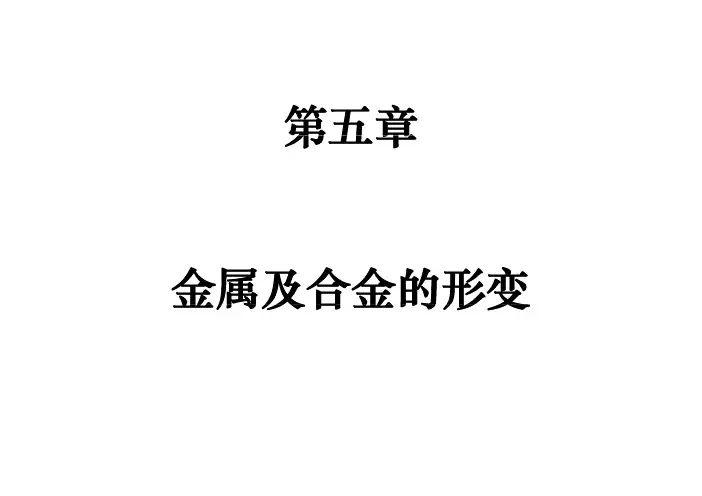
第五章金属及合金的形变金合金变金属及合金的塑性变形¾单晶体的滑移¾单晶体的应力-应变曲线及加工硬化¾孪生及扭折¾多晶体的塑性变形¾塑性变形后金属的结构、组织和性能单晶体的滑移滑移要素——滑移系(slip system)滑移是指在外力作用下晶体沿某些特定晶面和晶向相对滑开的形变方式。
滑移的特定晶面称为滑移面(slip plane),开的形变方式滑移的特定晶面称为滑移面特定晶向称为滑移方向(slip direction)。
滑移面和滑移方向合称为滑移要素。
合称为滑移要素对于一定的晶体结构,不论载荷大小或方向,滑移要素的类型一般都是确定的。
一般地,滑移面是晶体的密排面和较密排面,滑移方向是晶体的密排方向。
面心立方晶体:滑移面——{111}滑移方向——<110>体心立方晶体:滑移面——{110}、{112}、{123}滑移方向——<111>密排六方晶体:滑移面{}c/a>1.633 ——{0001}滑移方向——<11-20>c/a<1.633——{10-10}c/a<1.633 滑移面{1010}滑移方向——<11-23>一个滑移面和一个滑移方向组成一个滑移系(slip system)。
面心立方结构有12个滑移系;体心立方结构有48个滑移系;密排六方结构有3个滑移系;在外力作用下,并不是所有的滑移系都会开动,只能是其中一个或几个滑移系开动,那些没有开动的滑移系称为潜在滑移系(potential slip system)。
滑移带与滑移线光学显微镜观察7%形变Al表面形貌扫描电镜观察形变Co单晶表面形貌Schmid 定律(临界分切应力定律)F==τm A ⋅⋅⋅σϕλcos cos 0取向因子(Orientation Factor )临界分切应力(Critical Resolved Shear Stress )Slip in a Zinc single crystal From C.F.ElamThe Distortion of Metal Crystals Oxford University Press London,1935London1935滑移系开动时,所需要的临界分切应力是和外力无关的常数,这个规律称为Schmid定律或临界分切应力定律。

第五章 金属的塑性和变形抗力从金属成形工艺的角度出发,我们总希望变形的金属或合金具有高的塑性和低的变形抗力。
随着生产的发展,出现了许多低塑性、高强度的新材料,需要采取相应的新工艺进行加工。
因此研究金属的塑性和变形抗力,是一个十分重要的问题。
本章的目的在于阐明金属塑性和变形抗力的概念,讨论各种因素对它们的影响。
§5.1 塑性、塑性指标、塑性图和变形抗力的概念所谓塑性,是指固体材料在外力作用下发生永久变形而又不破坏其完整性的能力。
人们常常容易把金属的塑性和硬度看作成反比的关系,即认为凡是硬度高的金属其塑性就差。
当然,有些金属是这样的,但并非都是如此,例如下列金属的情况: Fe HB =80 ψ=80%Ni HB =60 ψ=60%Mg HB =8 ψ=3%Sb HB =30 ψ=0%可见Fe 、Ni 不但硬度高,塑性也很好;而Mg 、Sb 虽然硬度低,但塑性也很差。
塑性是和硬度无关的一种性能。
同样,人们也常把塑性和材料的变形抗力对立起来,认为变形抗力高塑性就低,变形抗力低塑性就高,这也是和事实不符合的。
例如奥氏体不锈钢在室温下可以经受很大的变形而不破坏,既这种钢具有很高的塑性,但是使它变形却需要很大的压力,即同时它有很高的变形抗力。
可见,塑性和变形抗力是两个独立的指标。
为了衡量金属塑性的高低,需要一种数量上的指标来表示,称塑性指标。
塑性指标是以金属材料开始破坏时的塑性变形量来表示。
常用的塑性指标是拉伸试验时的延伸率δ和断面缩小率ψ,δ和ψ由下式确定: %100l l l 00k ×−=δ (5.1) %100F F F 0K 0×−=ψ (5.2) 式中l 0、F 0——试样的原始标距长度和原始横截面积;l K 、F K ——试样断裂后标距长度和试样断裂处最小横截面积。
实际上,这两个指标只能表示材料在单向拉伸条件下的塑性变形能力。
金属的塑性指标除了用拉伸试验之外,还可以用镦粗试验、扭转试验等来测定。
第四章铁碳合金(一)填空题1.Cr、V在γ-Fe中将形成置换固溶体。
C、N则形成间隙固溶体。
2.渗碳体的晶体结构是复杂正交晶系,按其化学式铁与碳原子的个数比为3:1 3.当一块质量一定的纯铁加热到912℃温度时,将发生a-Fe向γ-Fe的转变,此时体积将发生缩小。
4.共析成分的铁碳合金平衡结晶至室温时,其相组成物为α+ Fe3C,组织成物为P。
5.在生产中,若要将钢进行轧制或锻压时,必须加热至γ单相区。
6.当铁碳合金冷却时发生共晶反应的反应式为,其反应产物在室温下被称为。
7.在退火状态的碳素工具钢中,T8钢比T12 钢的硬度,强度。
8.当W(C)=0.77%一2.11%间的铁碳合金从高温缓冷至ES线以下时,将从奥氏体中析出,其分布特征是。
9.在铁碳合金中,含三次渗碳体最多的合金成分点为,含二次渗碳体最多的合金成分点为。
10.对某亚共析碳钢进行显微组织观察时,若估计其中铁素体约占10%,其W(C) = ,大致硬度为11.奥氏体是在的固溶体,它的晶体结构是。
12.铁素体是在的固溶体,它的晶体结构是。
13.渗碳体是和的金属间化合物。
14.珠光体是和的机械混合物。
15.莱氏体是和的机械混合物,而变态莱氏体是和的机械混合物。
16.在Fe—Fe3C相图中,有、、、、五种渗碳体,它们各自的形态特征是、、、、。
17.钢中常存杂质元素有、、、等,其中、是有害元素,它们分别使钢产生、。
18.纯铁在不同温度区间的同素异晶体有(写出温度区间) 、、。
19.碳钢按相图分为、、;按W(C)分为(标出W(C)范围) 、、。
10.在铁—渗碳体相图中,存在着四条重要的线,请说明冷却通过这些线时所发生的转变并指出生成物。
ECF水平线、;PSK水平线、;ES 线、;GS线、。
21 标出Fe—Fe3C相图(图4—3)中指定相区的相组成物:①,②,③,④,⑤。
;22.铁碳合金的室温显微组织由和两种基本相组成。
23.若退火碳钢试样中先共析铁素体面积为41.6%,珠光体的面积为58.4%,则其W(C)=。